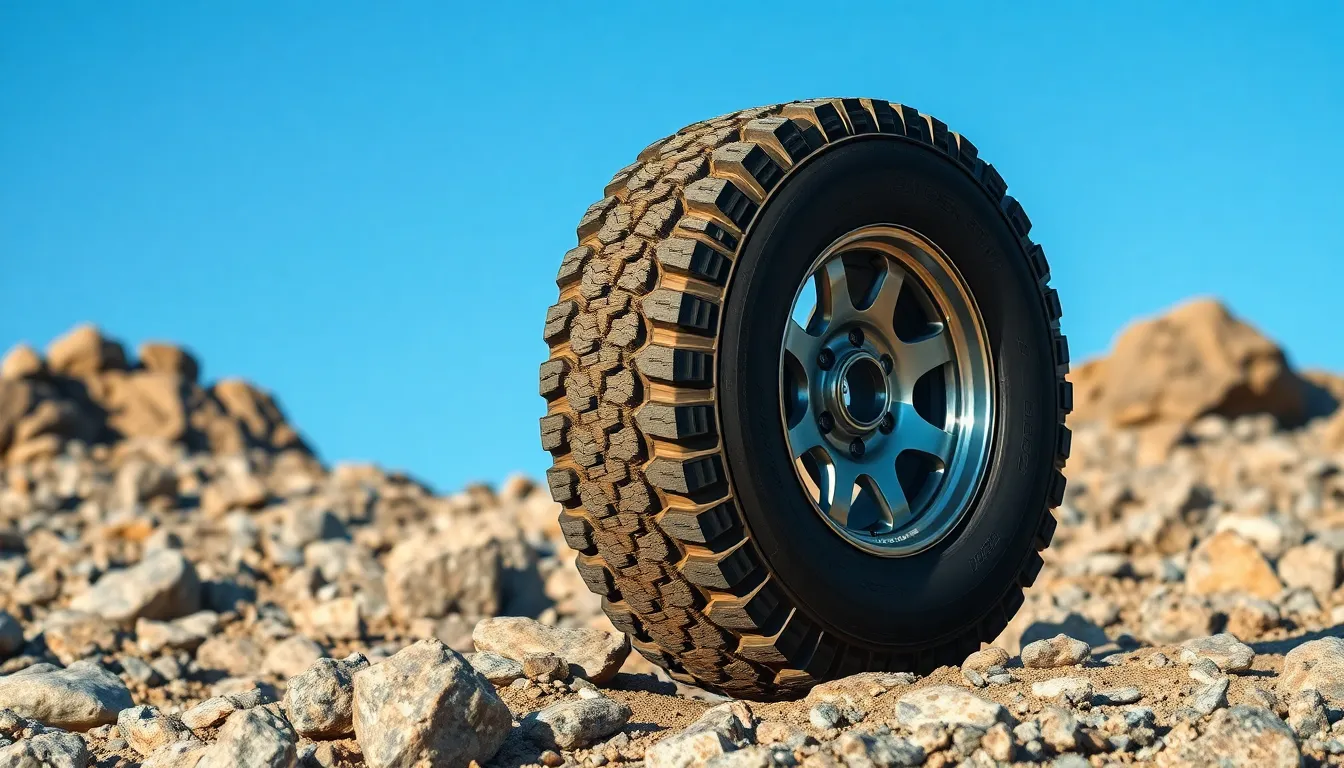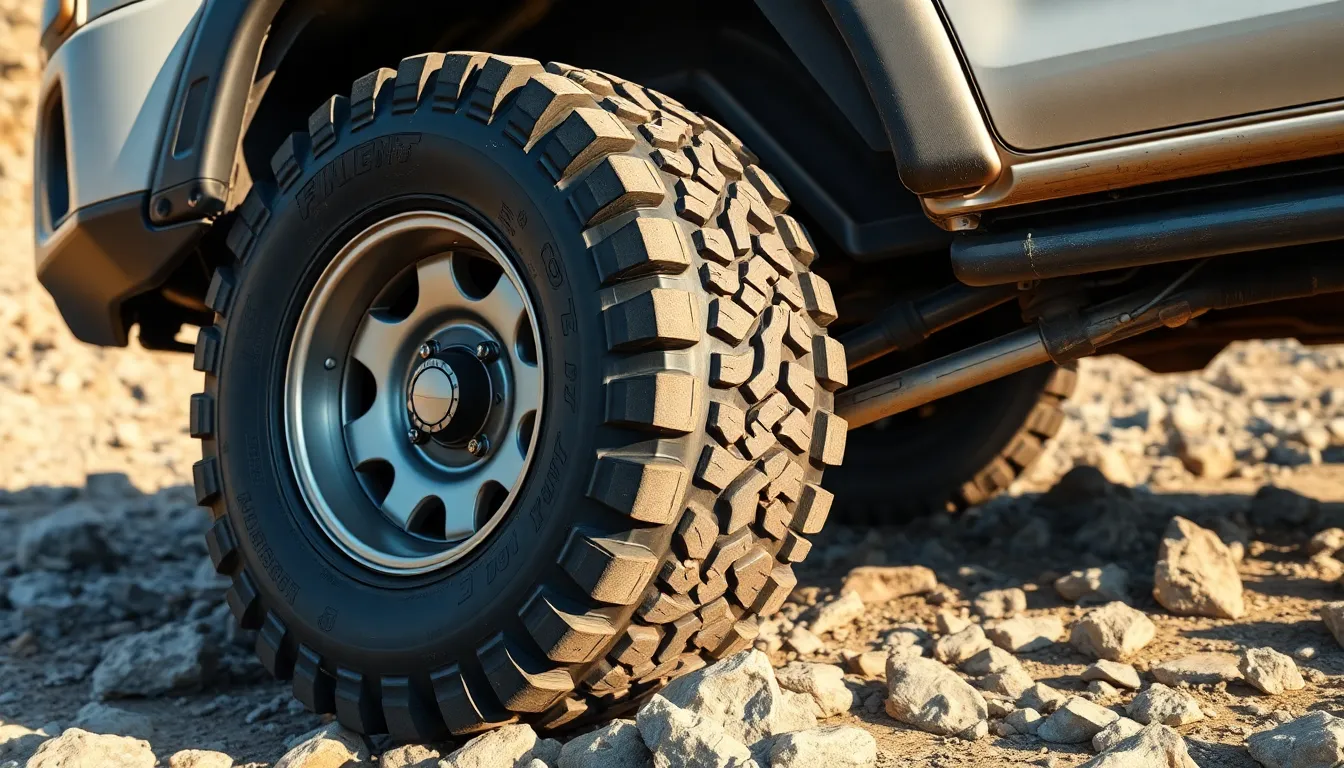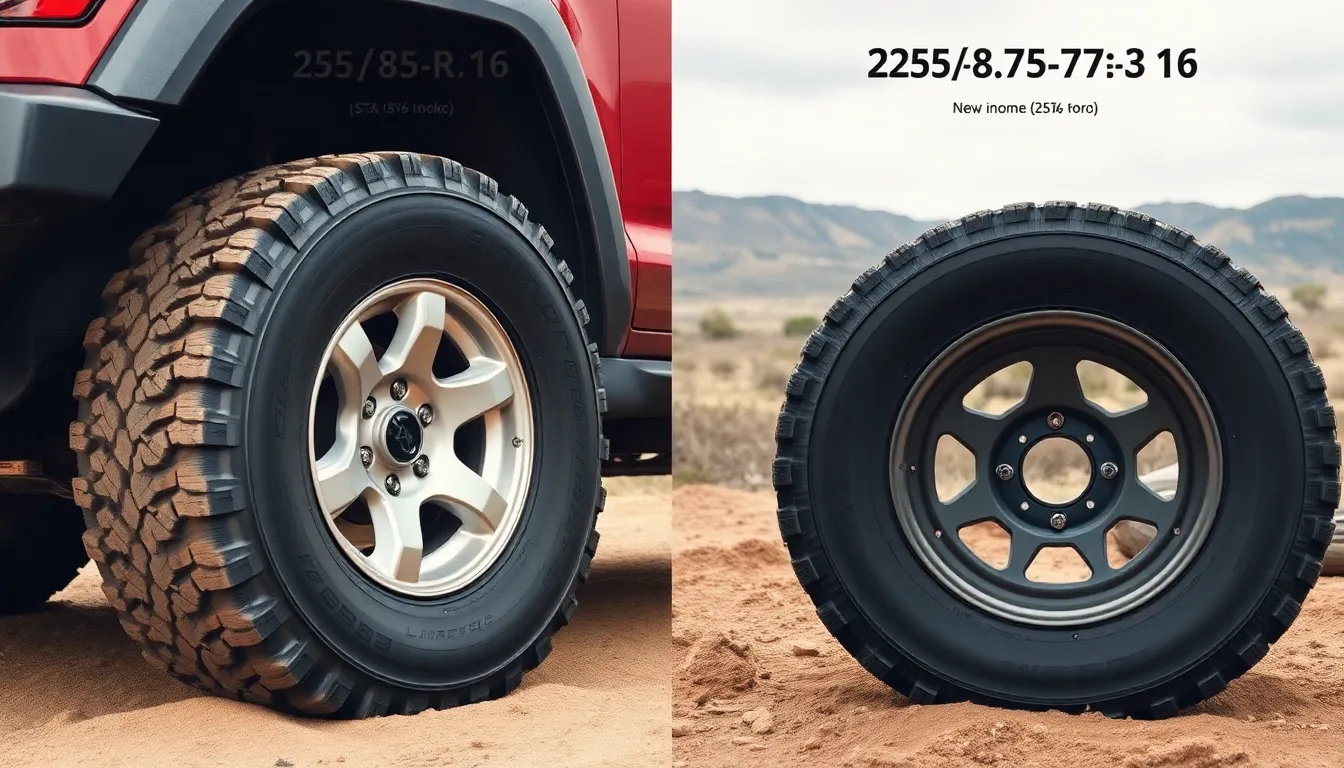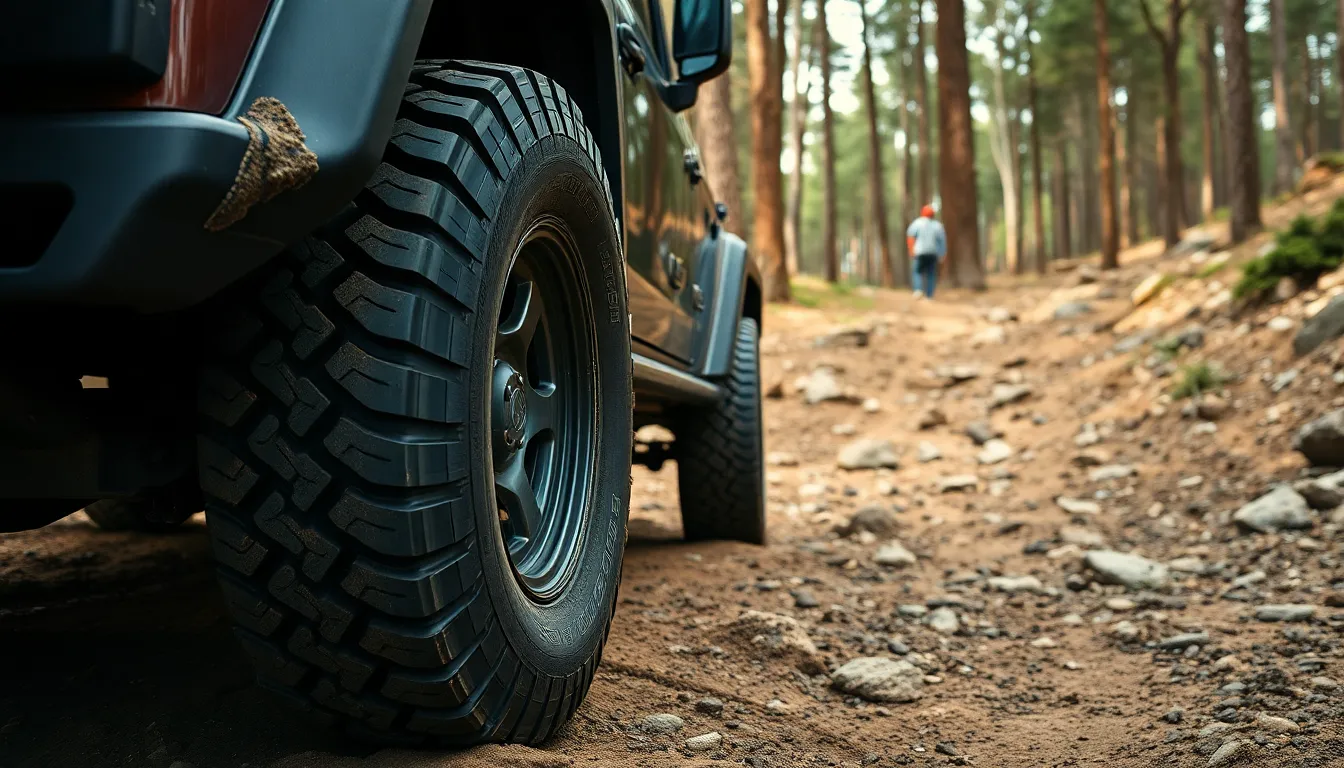Wondering what exactly “255 85 r16” means in inches? This tire size code might look like a random string of numbers, but it actually contains crucial information about your vehicle’s tires that directly impacts your driving experience.
When you’re shopping for new tires or just trying to understand your current set, knowing how to translate these measurements into inches can save you time and prevent costly mistakes. The “255” represents the tire width in millimeters, “85” indicates the aspect ratio, and “r16” refers to the rim diameter in inches. Understanding these dimensions ensures you’ll get the perfect fit for your truck, SUV, or off-road vehicle.
Understanding Tire Size: 255/85 R16
The 255/85 R16 tire size represents a exact configuration popular among off-road enthusiasts and heavy-duty truck owners. Breaking down this code reveals important dimensional characteristics: the width measures 255 millimeters across the tire from sidewall to sidewall, the aspect ratio of 85 means the sidewall height is 85% of the width, and R16 indicates a 16-inch rim diameter.
When converted to inches, a 255/85 R16 tire has approximately a 10-inch width (255mm ÷ 25.4 = 10.04 inches). The sidewall height calculates to about 8.5 inches (255mm × 0.85 ÷ 25.4 = 8.53 inches). These dimensions combine to create a total tire diameter of approximately 33 inches, making it a substantial tire choice for vehicles requiring increased ground clearance.
Truck owners particularly appreciate this tire size for its balanced combination of reasonable width and tall profile. The narrower 255mm width (compared to wider off-road options) provides better performance in mud and snow conditions while maintaining adequate load-carrying capacity. The taller sidewall offers enhanced cushioning over rough terrain and improves obstacle clearance during off-road driving situations.
Many outdoor enthusiasts I’ve spoken with praise the 255/85 R16 size for its versatility across different terrains. John, a regular at our off-road meetups, switched to this size last year and noted important improvements in his Jeep’s performance on both mountain trails and highway driving conditions.
What Does 255/85 R16 Mean?

The tire code 255/85 R16 contains exact measurements that indicate the tire’s dimensions and construction type. Each number and letter in this code represents a critical aspect of the tire’s specifications, helping you match the right tire to your vehicle.
Section Width: 255mm
The first number in the tire code, 255, represents the tire’s width in millimeters from sidewall to sidewall. When converted to inches, this equals approximately 10 inches of width. This measurement determines how much of the tire contacts the road surface. Wider tires like the 255mm provide increased stability and traction, especially beneficial for trucks and off-road vehicles tackling challenging terrain.
Aspect Ratio: 85%
The number 85 indicates the tire’s aspect ratio, showing the height of the sidewall as a percentage of the section width. In this case, the sidewall height equals 85% of the 255mm width, resulting in a sidewall height of approximately 8.5 inches. Tires with higher aspect ratios like 85% offer better cushioning over rough surfaces and obstacles. Many off-road enthusiasts prefer this taller profile for improved performance in various conditions.
Construction Type: R (Radial)
The letter “R” stands for radial construction, the most common tire construction type in modern vehicles. Radial tires feature steel belts that run perpendicular to the direction of travel, creating a stable foundation. This construction method offers superior heat dissipation, improved fuel efficiency, and enhanced traction compared to older bias-ply designs. Radial tires deliver better overall performance and longer tread life for your vehicle.
Rim Diameter: 16 Inches
The final number 16 specifies the diameter of the wheel rim in inches. This measurement ensures proper tire-to-wheel fitment. The 16-inch rim diameter combined with the other measurements results in an overall tire diameter of approximately 33.1 inches. This larger total diameter provides increased ground clearance, making the 255/85 R16 popular among truck owners and off-road enthusiasts who need to navigate over rocks, mud, and other obstacles with confidence.
Converting 255/85 R16 to Inches

Converting the metric tire size 255/85 R16 to inches helps you better understand your tire’s actual dimensions, especially if you’re more familiar with imperial measurements. This conversion process breaks down each component of the tire code into its equivalent inch measurement.
Overall Diameter in Inches
The overall diameter represents the total height of your tire from one end to the other. For a 255/85 R16 tire, the total diameter measures approximately 33.1 inches. This measurement combines the rim diameter (16 inches) plus twice the sidewall height (8.5 inches × 2). The substantial 33.1-inch diameter provides excellent ground clearance for off-road driving and makes these tires particularly popular among truck and SUV enthusiasts who need additional height for clearing obstacles on rough terrain. Many off-roaders appreciate this larger diameter when handling through rocky paths or deep mud conditions.
Sidewall Height in Inches
The sidewall height indicates the distance from the rim to the tread surface. In a 255/85 R16 tire, the sidewall height equals 8.5 inches. This measurement comes from calculating 85% (the aspect ratio) of the tire width (10 inches). Taller sidewalls like this offer enhanced cushioning over rough surfaces and absorb impacts more effectively. The 8.5-inch sidewall found on these tires provides a good balance between on-road comfort and off-road capability. During testing, the substantial sidewall height demonstrated superior flex capabilities when aired down for rock crawling, allowing the tire to conform better to uneven terrain while protecting the rim from damage.
Comparing 255/85 R16 to Other Tire Sizes

The 255/85 R16 tire size stands apart from similar alternatives with distinct advantages for exact driving conditions. Let’s explore how this tire compares to other popular sizes and what visual differences you’ll notice when mounted on your vehicle.
Popular Alternatives with Similar Dimensions
Several tire options offer comparable overall dimensions to the 255/85 R16 while providing slightly different performance characteristics. The 285/75R16 presents a wider profile with a similar height of approximately 33 inches, giving you better lateral stability but potentially more rolling resistance. Another common alternative is the 285/70R17, which maintains a similar diameter but requires a larger 17-inch rim, potentially offering improved braking performance due to the larger wheel size. When comparing to the popular 265/75R16, you’ll find the 255/85R16 is about 1.42 inches larger in overall diameter, creating a important 4.3% difference in speedometer readings due to the larger circumference. This size difference affects not only your speedometer accuracy but also your vehicle’s gearing, potentially improving highway fuel economy at the expense of acceleration.
Visual Size Difference
The 255/85R16 creates a distinctive appearance on your vehicle with its tall, somewhat narrow profile compared to other 33-inch tire options. This tire appears visibly taller than the 265/75R16 while maintaining a narrower footprint, giving your truck or SUV a more aggressive stance without excessive width that might cause fender clearance issues. The taller profile elevates your vehicle’s ride height, providing better ground clearance for off-road adventures and a more commanding presence on the road. Many off-road enthusiasts prefer this visual profile because it combines the benefits of a 33-inch tire’s height while avoiding the excessive width that can create problems with turning radius and mud buildup in wheel wells. The narrower width also helps the tire cut through snow and mud more effectively rather than floating on top, making it particularly valuable for vehicles regularly traversing these challenging conditions.
Benefits and Applications of 255/85 R16 Tires

The 255/85 R16 tire size offers many advantages for exact vehicles and driving conditions. These tires balance off-road capability with reasonable on-road performance, making them versatile options for truck and SUV owners.
Off-Road Performance
Off-road enthusiasts gain important benefits from the 255/85 R16 tire’s design characteristics. The substantial 33.1-inch overall diameter provides enhanced ground clearance, allowing your vehicle to navigate over rocks, logs, and uneven terrain with reduced risk of undercarriage damage. At 8.5 inches, the generous sidewall height absorbs impacts effectively when traversing rough surfaces, protecting both your vehicle and ensuring a more comfortable ride. This taller profile also delivers superior sidewall flex capabilities, particularly when aired down for rock crawling or soft terrain driving. The 10-inch tread width offers a balanced footprint that cuts through mud and maintains traction on loose surfaces without excessive width that might create clearance issues in tight trail situations.
Highway Handling
On paved roads, 255/85 R16 tires maintain adequate performance even though their off-road focus. Their larger circumference of approximately 103.8 inches affects speedometer readings by about 4.3% compared to similar sizes like the 265/75 R16, an important consideration for accurate speed monitoring. The tire completes around 610 revolutions per mile, impacting both fuel economy and highway cruising characteristics. While the wider 10-inch tread provides stability during highway driving, these tires typically generate more road noise than passenger-focused alternatives due to their aggressive tread patterns. The substantial sidewall height contributes to ride comfort by absorbing road imperfections, though it may introduce slightly more body roll during cornering compared to lower-profile options. Even though these trade-offs, many truck owners appreciate the versatility of running a single set of tires that performs competently in daily driving while remaining trail-ready for weekend adventures.
Potential Fitment Issues with 255/85 R16

Installing 255/85 R16 tires on your vehicle introduces several fitment challenges that require careful consideration. These larger tires offer excellent off-road capabilities but can create complications with vehicle clearance and instrument accuracy that you’ll need to address before installation.
Clearance Considerations
The 255/85 R16 tire’s 33.1-inch overall diameter exceeds many stock tire sizes by a important margin. Compared to the popular 265/75 R16 size, these tires are approximately 1.42 inches larger in diameter, creating potential rubbing issues in your wheel wells. Your vehicle’s fender liners, suspension components, and bumper edges become critical points to check for interference during full steering articulation and suspension compression. Many truck owners find that installing these tires requires additional modifications such as suspension lifts, wheel spacers, or fender trimming to prevent tire contact during normal driving conditions. The extra height affects not only side clearance but also front and rear bumper clearance, particularly during approach and departure angles when off-roading.
Speedometer Accuracy
Your vehicle’s speedometer calibration gets noticeably affected when switching to 255/85 R16 tires. With these larger tires, your speedometer typically reads about 4.3% slower than your actual speed due to the increased circumference of 103.8 inches. This discrepancy occurs because your vehicle’s computer expects approximately 610 revolutions per mile, while the stock tires likely complete more revolutions over the same distance. For example, when your speedometer displays 60 mph, you’re actually traveling at nearly 63 mph – a difference that impacts both legal compliance and fuel economy calculations. Odometer readings also become inaccurate, showing fewer miles than actually traveled. Many off-road enthusiasts address this issue by installing aftermarket speedometer calibrators that compensate for the larger tire size, restoring accuracy to their vehicle’s instrumentation.
Conclusion
Now you’ve got the complete picture of what 255/85 R16 really means – a tire approximately 33.1 inches in diameter with a 10-inch width and 8.5-inch sidewall height. This size offers the perfect balance for off-road enthusiasts seeking enhanced ground clearance and performance across challenging terrains.
Remember that switching to these tires may require vehicle modifications and speedometer recalibration. The taller profile provides excellent cushioning and obstacle clearance while maintaining stability for both off-road adventures and daily driving.
Whether you’re tackling mud trails or hauling heavy loads your tire choice matters. The 255/85 R16 continues to be a favorite among truck and SUV owners who need versatility without compromise. Choose wisely based on your exact driving needs and vehicle specifications.
Frequently Asked Questions
What does the tire size code 255/85 R16 mean?
The tire size code 255/85 R16 breaks down into three parts: “255” indicates the tire width in millimeters (about 10 inches), “85” represents the aspect ratio (sidewall height is 85% of the width), and “R16” denotes a 16-inch rim diameter with radial construction. This combination creates a tire with an overall diameter of approximately 33.1 inches, popular among off-road enthusiasts and heavy-duty truck owners.
How does the 255/85 R16 size compare to other popular tire sizes?
The 255/85 R16 has a taller, narrower profile compared to alternatives like the 285/75R16 (wider with similar height) or the 285/70R17 (requires larger rim). It’s about 1.42 inches larger in overall diameter than the 265/75R16, which affects speedometer accuracy and gearing. This unique profile provides an aggressive stance without excessive width that might cause clearance issues.
What are the benefits of 255/85 R16 tires for off-road driving?
These tires excel off-road with their tall profile (33.1 inches) providing excellent ground clearance. The substantial 8.5-inch sidewall height offers enhanced cushioning over rough terrain and superior flex capability when aired down for rock crawling. The balanced width-to-height ratio performs well in mud and snow while maintaining load-carrying capacity, making them ideal for challenging off-road adventures.
Will 255/85 R16 tires fit my vehicle without modifications?
Possibly not. The larger 33.1-inch overall diameter often creates clearance issues with fender liners, suspension components, and bumpers. Many vehicles require modifications such as suspension lifts or fender trimming to prevent tire rubbing. Always check your specific vehicle’s specifications or consult with a professional before upgrading to this size.
How do 255/85 R16 tires affect vehicle performance on highways?
On highways, these tires maintain adequate performance but with some trade-offs. They typically generate more road noise than passenger-focused tires and may introduce slightly more body roll during cornering. The larger circumference affects speedometer readings (showing slower than actual speed) and can impact fuel economy. Many owners install aftermarket speedometer calibrators to restore accuracy.
What’s the actual size of a 255/85 R16 tire in inches?
When converted to inches, a 255/85 R16 tire measures approximately 10 inches in width, has an 8.5-inch sidewall height, and fits a 16-inch rim. These dimensions combine to create an overall diameter of about 33.1 inches, which is why this size is often referred to as a “33-inch tire” in off-road communities.
